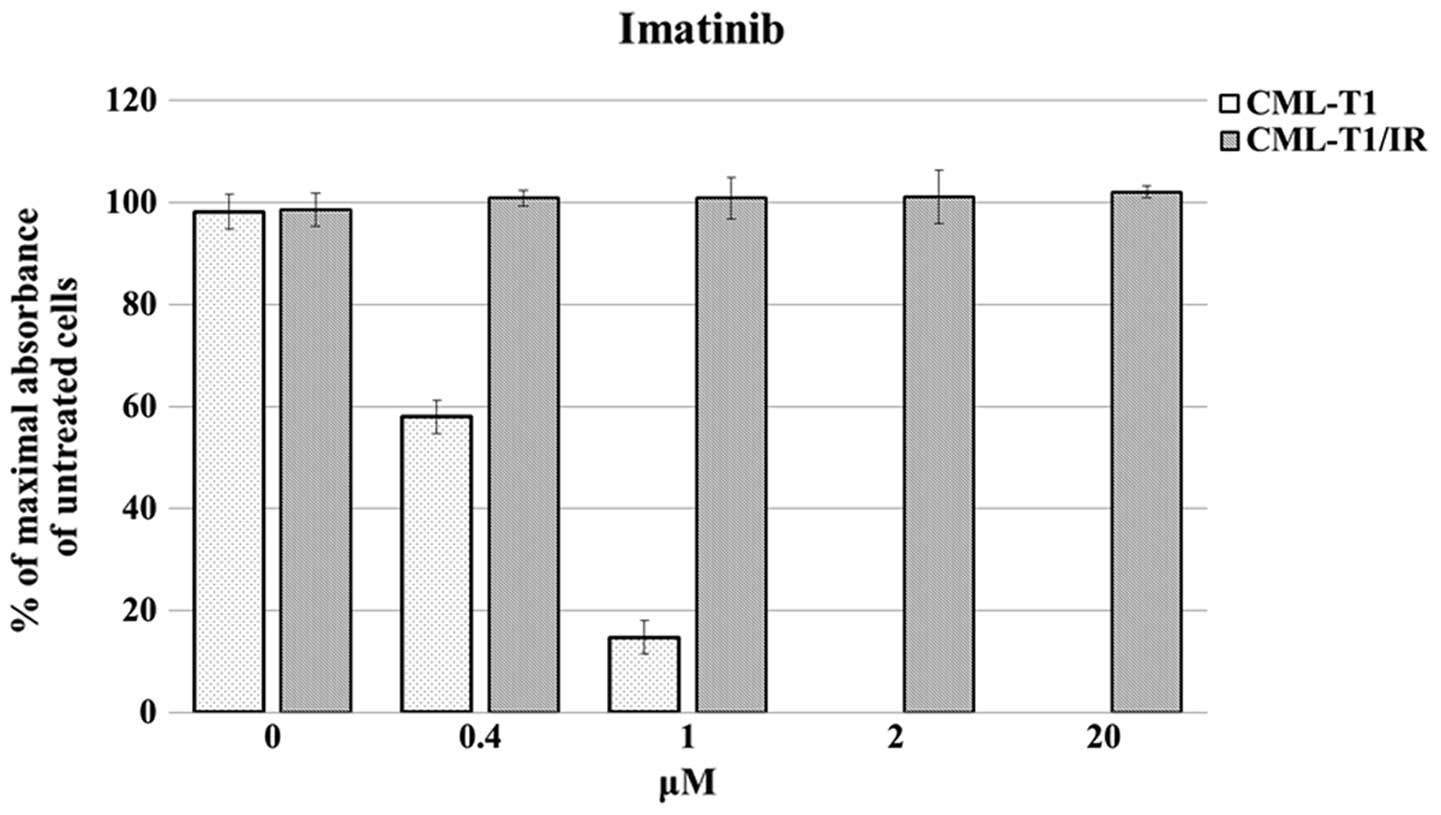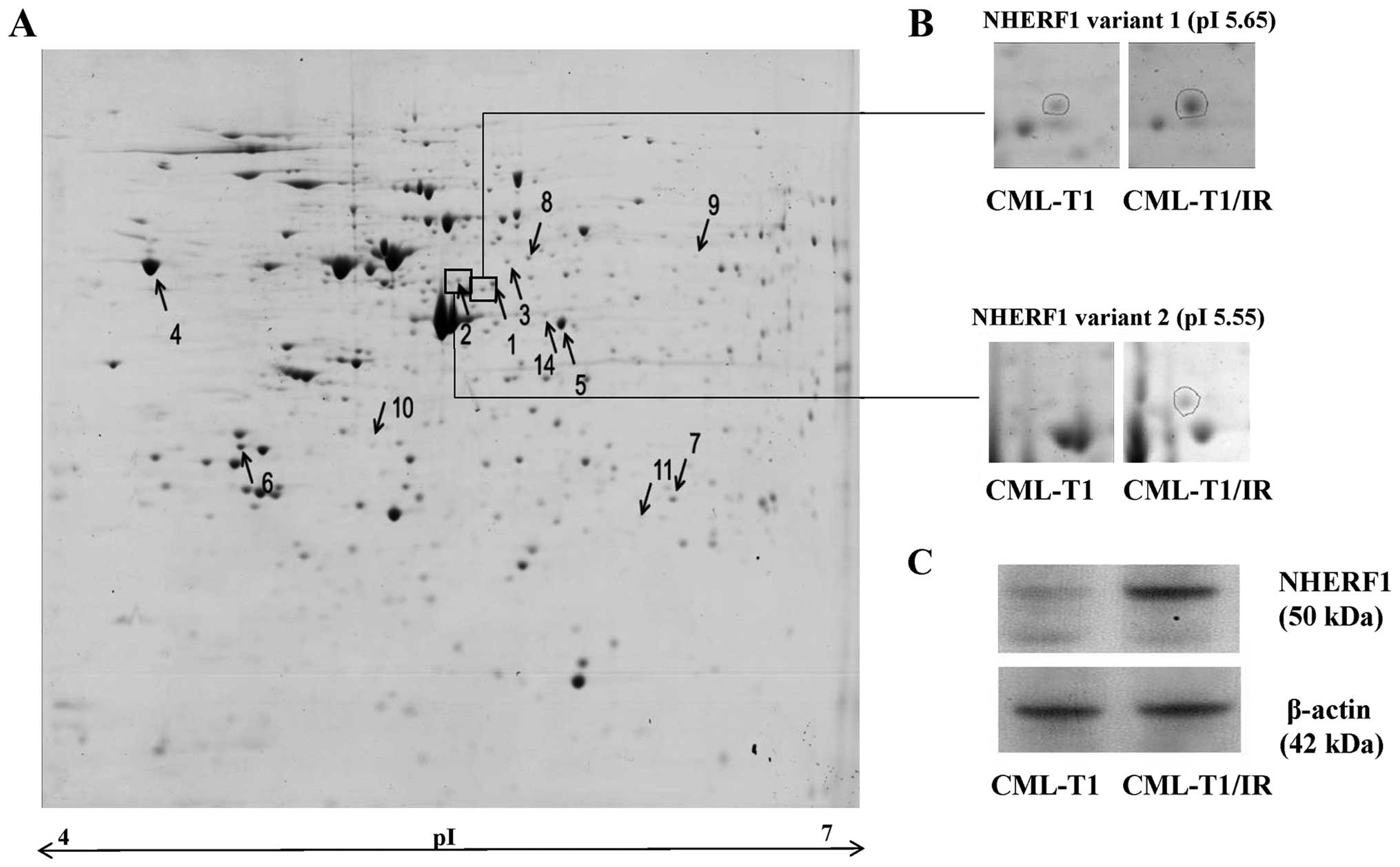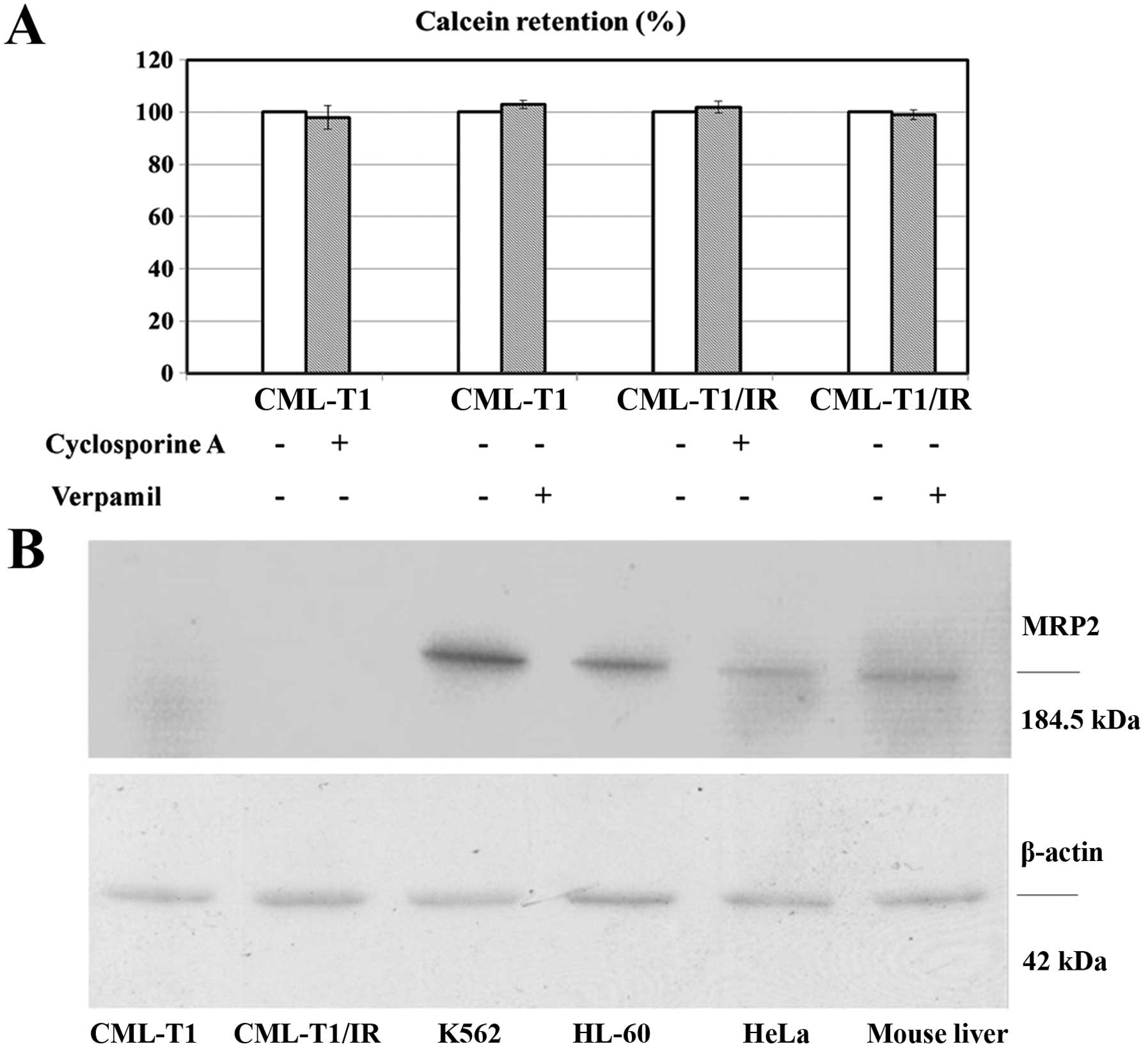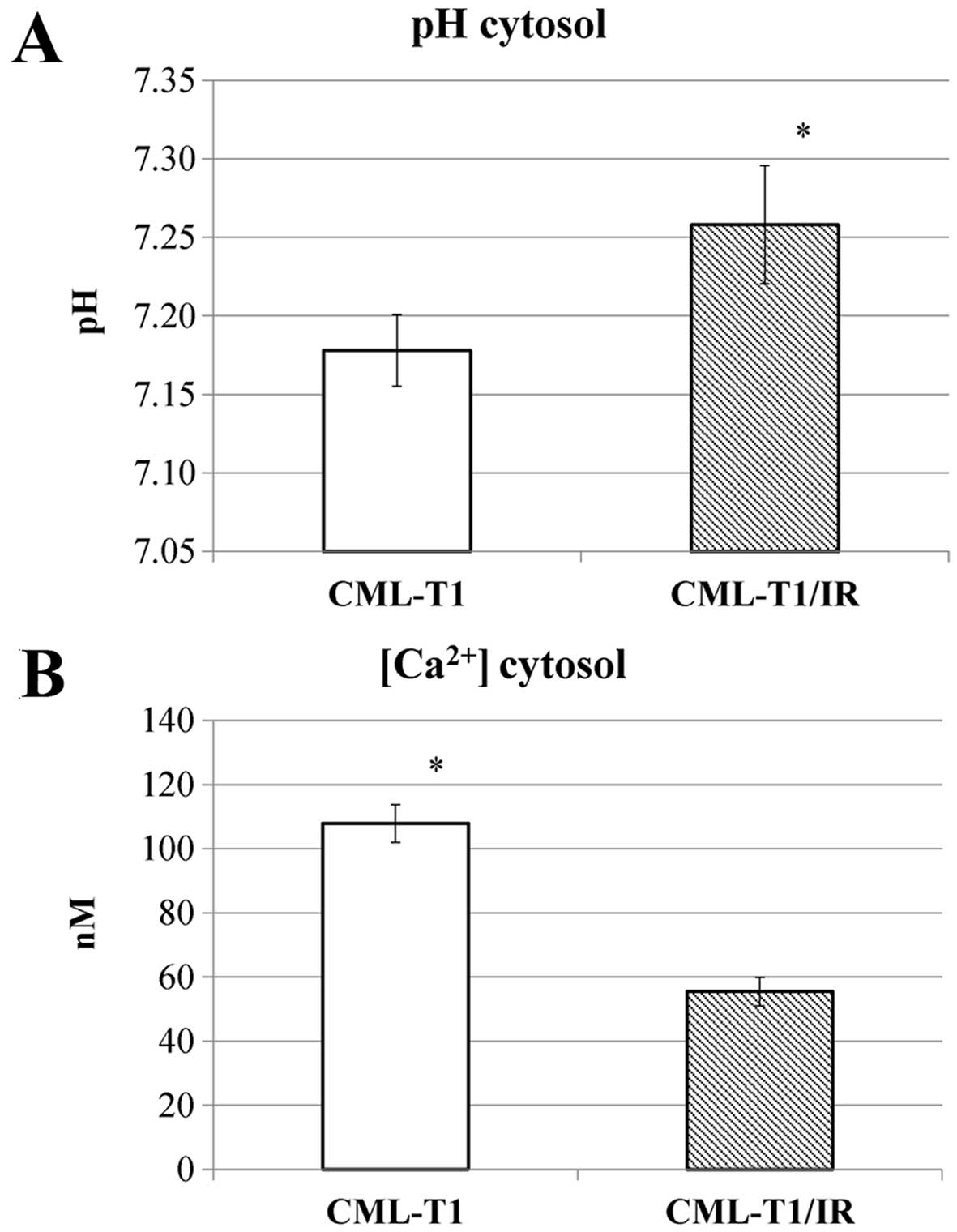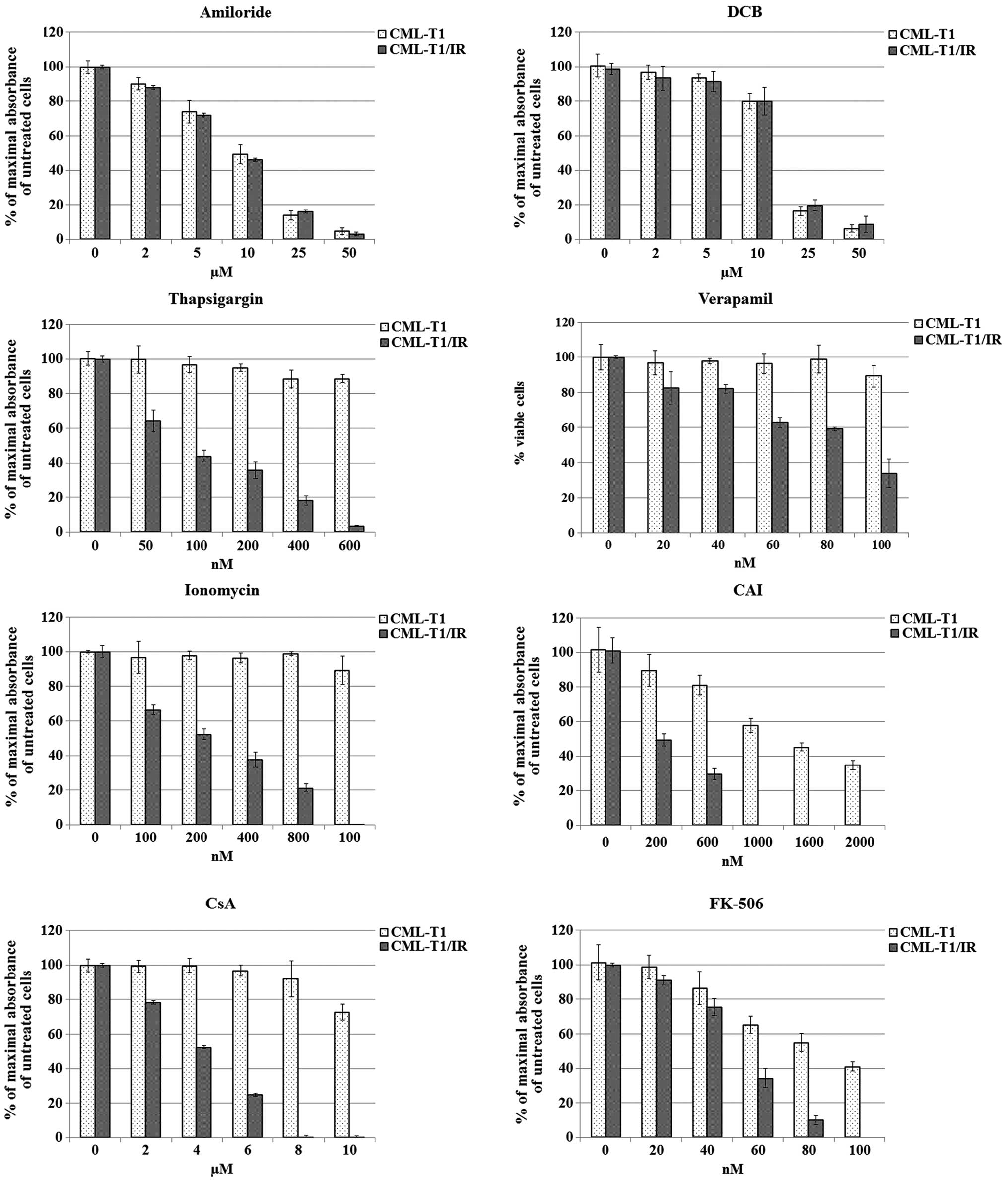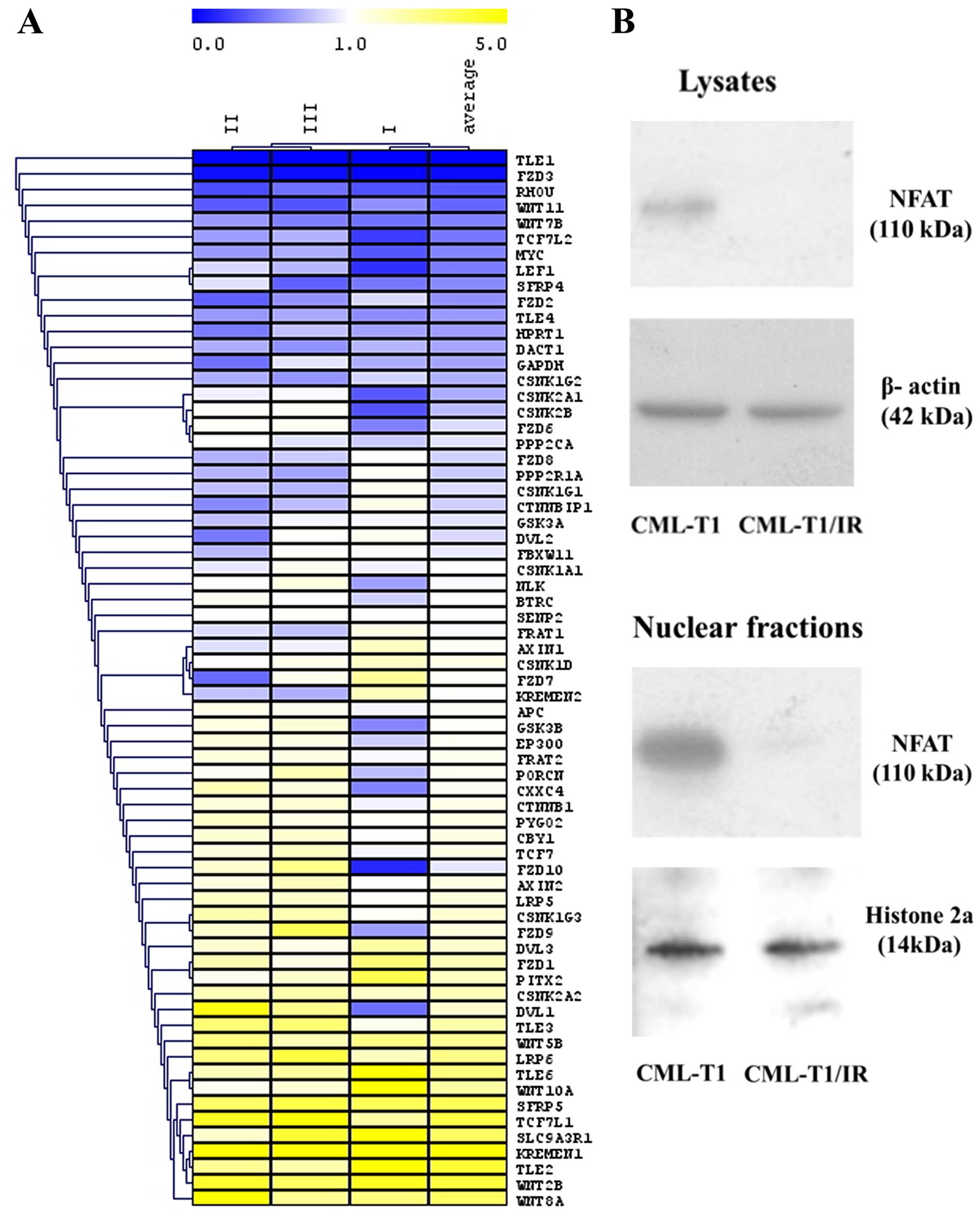|
1
|
Nowell PC and Hungerford DA: Chromosome
studies on normal and leukemic human leukocytes. J Natl Cancer
Inst. 25:85–109. 1960.PubMed/NCBI
|
|
2
|
Lugo TG, Pendergast AM, Muller AJ and
Witte ON: Tyrosine kinase activity and transformation potency of
bcr-abl oncogene products. Science. 247:1079–1082. 1990. View Article : Google Scholar : PubMed/NCBI
|
|
3
|
Deininger MW, Vieira S, Mendiola R,
Schultheis B, Goldman JM and Melo JV: BCR-ABL tyrosine kinase
activity regulates the expression of multiple genes implicated in
the pathogenesis of chronic myeloid leukemia. Cancer Res.
60:2049–2055. 2000.PubMed/NCBI
|
|
4
|
Hazlehurst LA, Bewry NN, Nair RR and
Pinilla-Ibarz J: Signaling networks associated with
BCR-ABL-dependent transformation. Cancer Control. 16:100–107.
2009.PubMed/NCBI
|
|
5
|
Waller CF: Imatinib mesylate. Recent
Results Cancer Res. 201:1–25. 2014. View Article : Google Scholar : PubMed/NCBI
|
|
6
|
Roche-Lestienne C, Soenen-Cornu V,
Grardel-Duflos N, Laï JL, Philippe N, Facon T, Fenaux P and
Preudhomme C: Several types of mutations of the Abl gene can be
found in chronic myeloid leukemia patients resistant to STI571, and
they can pre-exist to the onset of treatment. Blood. 100:1014–1018.
2002. View Article : Google Scholar : PubMed/NCBI
|
|
7
|
Kantarjian HM, Talpaz M, O'Brien S, Giles
F, Garcia-Manero G, Faderl S, Thomas D, Shan J, Rios MB and Cortes
J: Dose escalation of imatinib mesylate can overcome resistance to
standard-dose therapy in patients with chronic myelogenous
leukemia. Blood. 101:473–475. 2003. View Article : Google Scholar
|
|
8
|
Ursan ID, Jiang R, Pickard EM, Lee TA, Ng
D and Pickard AS: Emergence of BCR-ABL kinase domain mutations
associated with newly diagnosed chronic myeloid leukemia: A
meta-analysis of clinical trials of tyrosine kinase inhibitors. J
Manag Care Spec Pharm. 21:114–122. 2015. View Article : Google Scholar : PubMed/NCBI
|
|
9
|
Campbell LJ, Patsouris C, Rayeroux KC,
Somana K, Januszewicz EH and Szer J: BCR/ABL amplification in
chronic myelocytic leukemia blast crisis following imatinib
mesylate administration. Cancer Genet Cytogenet. 139:30–33. 2002.
View Article : Google Scholar
|
|
10
|
Phan CL, Megat Baharuddin PJNB, Chin LP,
Zakaria Z, Yegappan S, Sathar J, Tan S-M, Purushothaman V and Chang
KM: Amplification of BCR-ABL and t(3;21) in a patient with blast
crisis of chronic myelogenous leukemia. Cancer Genet Cytogenet.
180:60–64. 2008. View Article : Google Scholar
|
|
11
|
Roginskaya V, Zuo S, Caudell E, Nambudiri
G, Kraker AJ and Corey SJ: Therapeutic targeting of Src-kinase Lyn
in myeloid leukemic cell growth. Leukemia. 13:855–861. 1999.
View Article : Google Scholar : PubMed/NCBI
|
|
12
|
Quentmeier H, Eberth S, Romani J, Zaborski
M and Drexler HG: BCR-ABL1-independent PI3Kinase activation causing
imatinib-resistance. J Hematol Oncol. 4:62011. View Article : Google Scholar : PubMed/NCBI
|
|
13
|
Petrak J, Toman O, Simonova T, Halada P,
Cmejla R, Klener P and Zivny J: Identification of molecular targets
for selective elimination of TRAIL-resistant leukemia cells. From
spots to in vitro assays using TOP15 charts. Proteomics.
9:5006–5015. 2009. View Article : Google Scholar : PubMed/NCBI
|
|
14
|
Lorkova L, Scigelova M, Arrey TN, Vit O,
Pospisilova J, Doktorova E, Klanova M, Alam M, Vockova P, Maswabi
B, et al: Detailed functional and proteomic characterization of
fludarabine resistance in mantle cell lymphoma cells. PLoS One.
10:e01353142015. View Article : Google Scholar : PubMed/NCBI
|
|
15
|
Klanova M, Soukup T, Jaksa R, Molinsky J,
Lateckova L, Maswabi BCL, Prukova D, Brezinova J, Michalova K,
Vockova P, et al: Mouse models of mantle cell lymphoma, complex
changes in gene expression and phenotype of engrafted MCL cells:
Implications for preclinical research. Lab Invest. 94:806–817.
2014. View Article : Google Scholar : PubMed/NCBI
|
|
16
|
Poláková KM, Polívková V, Rulcová J,
Klamová H, Jurcek T, Dvoráková D, Zácková D, Pospísil Z, Mayer J
and Moravcová J: Constant BCR-ABL transcript level ≥0.1% (IS) in
patients with CML responding to imatinib with complete cytogenetic
remission may indicate mutation analysis. Exp Hematol. 38:20–26.
2010. View Article : Google Scholar
|
|
17
|
Machova Polakova K, Kulvait V, Benesova A,
Linhartova J, Klamova H, Jaruskova M, de Benedittis C, Haferlach T,
Baccarani M, Martinelli G, et al: Next-generation deep sequencing
improves detection of BCR-ABL1 kinase domain mutations emerging
under tyrosine kinase inhibitor treatment of chronic myeloid
leukemia patients in chronic phase. J Cancer Res Clin Oncol.
141:887–899. 2015. View Article : Google Scholar
|
|
18
|
Kiedrowski L: Cytosolic zinc release and
clearance in hippocampal neurons exposed to glutamate - the role of
pH and sodium. J Neurochem. 117:231–243. 2011. View Article : Google Scholar : PubMed/NCBI
|
|
19
|
Kinsella BT, O'Mahony DJ and Fitzgerald
GA: The human thromboxane A2 receptor α isoform
(TPα) functionally couples to the G proteins
Gq and G11 in vivo and is activated by the
isoprostane 8-epi prostaglandin F2α. J Pharmacol Exp Ther.
281:957–964. 1997.PubMed/NCBI
|
|
20
|
Grynkiewicz G, Poenie M and Tsien RY: A
new generation of Ca2+ indicators with greatly improved
fluorescence properties. J Biol Chem. 260:3440–3450.
1985.PubMed/NCBI
|
|
21
|
White H, Deprez L, Corbisier P, Hall V,
Lin F, Mazoua S, Trapmann S, Aggerholm A, Andrikovics H, Akiki S,
et al: A certified plasmid reference material for the
standardisation of BCR-ABL1 mRNA quantification by real-time
quantitative PCR. Leukemia. 29:369–376. 2015. View Article : Google Scholar
|
|
22
|
Livak KJ and Schmittgen TD: Analysis of
relative gene expression data using real-time quantitative PCR and
the 2−ΔΔCt method. Methods. 25:402–408. 2001. View Article : Google Scholar
|
|
23
|
Kuriyama K, Gale RP, Tomonaga M, Ikeda S,
Yao E, Klisak I, Whelan K, Yakir H, Ichimaru M, Sparkes RS, et al:
CML-T1: A cell line derived from T-lymphocyte acute phase of
chronic myelogenous leukemia. Blood. 74:1381–1387. 1989.PubMed/NCBI
|
|
24
|
Drexler HG: Leukemia cell lines: In vitro
models for the study of chronic myeloid leukemia. Leuk Res.
18:919–927. 1994. View Article : Google Scholar : PubMed/NCBI
|
|
25
|
Hochhaus A, Kreil S, Corbin AS, La Rosée
P, Müller MC, Lahaye T, Hanfstein B, Schoch C, Cross NCP, Berger U,
et al: Molecular and chromosomal mechanisms of resistance to
imatinib (STI571) therapy. Leukemia. 16:2190–2196. 2002. View Article : Google Scholar : PubMed/NCBI
|
|
26
|
Branford S, Rudzki Z, Walsh S, Grigg A,
Arthur C, Taylor K, Herrmann R, Lynch KP and Hughes TP: High
frequency of point mutations clustered within the adenosine
triphosphate-binding region of BCR/ABL in patients with chronic
myeloid leukemia or Ph-positive acute lymphoblastic leukemia who
develop imatinib (STI571) resistance. Blood. 99:3472–3475. 2002.
View Article : Google Scholar : PubMed/NCBI
|
|
27
|
Kominsky DJ, Klawitter J, Brown JL, Boros
LG, Melo JV, Eckhardt SG and Serkova NJ: Abnormalities in glucose
uptake and metabolism in imatinib-resistant human BCR-ABL-positive
cells. Clin Cancer Res. 15:3442–3450. 2009. View Article : Google Scholar : PubMed/NCBI
|
|
28
|
Adamia S, Pilarski PM, Bar-Natan M, Stone
RM and Griffin JD: Alternative splicing in chronic myeloid leukemia
(CML): A novel therapeutic target? Curr Cancer Drug Targets.
13:735–748. 2013. View Article : Google Scholar : PubMed/NCBI
|
|
29
|
Reczek D, Berryman M and Bretscher A:
Identification of EBP50: A PDZ-containing phosphoprotein that
associates with members of the ezrin-radixin-moesin family. J Cell
Biol. 139:169–179. 1997. View Article : Google Scholar : PubMed/NCBI
|
|
30
|
Ardura JA and Friedman PA: Regulation of G
protein-coupled receptor function by Na+/H+
exchange regulatory factors. Pharmacol Rev. 63:882–900. 2011.
View Article : Google Scholar : PubMed/NCBI
|
|
31
|
Li M, Wang W, Soroka CJ, Mennone A, Harry
K, Weinman EJ and Boyer JL: NHERF-1 binds to Mrp2 and regulates
hepatic Mrp2 expression and function. J Biol Chem. 285:19299–19307.
2010. View Article : Google Scholar : PubMed/NCBI
|
|
32
|
He P and Yun CC: Mechanisms of the
regulation of the intestinal Na+/H+ exchanger
NHE3. J Biomed Biotechnol. 2010:2380802010.
|
|
33
|
Obukhov AG and Nowycky MC: TRPC5
activation kinetics are modulated by the scaffolding protein
ezrin/radixin/moesin-binding phosphoprotein-50 (EBP50). J Cell
Physiol. 201:227–235. 2004. View Article : Google Scholar : PubMed/NCBI
|
|
34
|
Tang Y, Tang J, Chen Z, Trost C, Flockerzi
V, Li M, Ramesh V and Zhu MX: Association of mammalian Trp4 and
phospholipase C isozymes with a PDZ domain-containing protein,
NHERF. J Biol Chem. 275:37559–37564. 2000. View Article : Google Scholar : PubMed/NCBI
|
|
35
|
Wheeler DS, Barrick SR, Grubisha MJ,
Brufsky AM, Friedman PA and Romero G: Direct interaction between
NHERF1 and Frizzled regulates β-catenin signaling. Oncogene.
30:32–42. 2011. View Article : Google Scholar
|
|
36
|
Karvar S, Suda J, Zhu L and Rockey DC:
Distribution dynamics and functional importance of NHERF1 in
regulation of Mrp-2 trafficking in hepatocytes. Am J Physiol Cell
Physiol. 307:C727–C737. 2014. View Article : Google Scholar : PubMed/NCBI
|
|
37
|
Bosch I and Croop J: P-glycoprotein
multidrug resistance and cancer. Biochim Biophys Acta.
1288:F37–F54. 1996.PubMed/NCBI
|
|
38
|
Canitrot Y, Lahmy S, Buquen JJ, Canitrot D
and Lautier D: Functional study of multidrug resistance with
fluorescent dyes. Limits of the assay for low levels of resistance
and application in clinical samples. Cancer Lett. 106:59–68. 1996.
View Article : Google Scholar : PubMed/NCBI
|
|
39
|
Donowitz M, Cha B, Zachos NC, Brett CL,
Sharma A, Tse CM and Li X: NHERF family and NHE3 regulation. J
Physiol. 567:3–11. 2005. View Article : Google Scholar : PubMed/NCBI
|
|
40
|
Garciarena CD, Youm JB, Swietach P and
Vaughan-Jones RD: H+-activated Na+ influx in
the ventricular myocyte couples
Ca2+-signalling to intracellular pH. J Mol
Cell Cardiol. 61:51–59. 2013. View Article : Google Scholar : PubMed/NCBI
|
|
41
|
Rich IN, Worthington-White D, Garden OA
and Musk P: Apoptosis of leukemic cells accompanies reduction in
intracellular pH after targeted inhibition of the
Na+/H+ exchanger. Blood. 95:1427–1434.
2000.PubMed/NCBI
|
|
42
|
Pinton P, Ferrari D, Magalhães P,
Schulze-Osthoff K, Di Virgilio F, Pozzan T and Rizzuto R: Reduced
loading of intracellular Ca2+ stores and downregulation
of capacitative Ca2+ influx in Bcl-2-overexpressing
cells. J Cell Biol. 148:857–862. 2000. View Article : Google Scholar : PubMed/NCBI
|
|
43
|
Condrescu M, Opuni K, Hantash BM and
Reeves JP: Cellular regulation of sodium-calcium exchange. Ann NY
Acad Sci. 976:214–223. 2002. View Article : Google Scholar : PubMed/NCBI
|
|
44
|
Iwamoto T, Watanabe Y, Kita S and
Blaustein MP: Na+/Ca2+ exchange inhibitors: A
new class of calcium regulators. Cardiovasc Hematol Disord Drug
Targets. 7:188–198. 2007. View Article : Google Scholar : PubMed/NCBI
|
|
45
|
Thastrup O, Cullen PJ, Drøbak BK, Hanley
MR and Dawson AP: Thapsigargin, a tumor promoter, discharges
intracellular Ca2+ stores by specific inhibition of the
endoplasmic reticulum Ca2+-ATPase. Proc Natl Acad Sci
USA. 87:2466–2470. 1990. View Article : Google Scholar
|
|
46
|
Inesi G, Hua S, Xu C, Ma H, Seth M, Prasad
AM and Sumbilla C: Studies of Ca2+ ATPase (SERCA)
inhibition. J Bioenerg Biomembr. 37:365–368. 2005. View Article : Google Scholar
|
|
47
|
Beeler TJ, Jona I and Martonosi A: The
effect of ionomycin on calcium fluxes in sarcoplasmic reticulum
vesicles and liposomes. J Biol Chem. 254:6229–6231. 1979.PubMed/NCBI
|
|
48
|
Triggle DJ: L-type calcium channels. Curr
Pharm Des. 12:443–457. 2006. View Article : Google Scholar : PubMed/NCBI
|
|
49
|
Hupe DJ, Boltz R, Cohen CJ, Felix J, Ham
E, Miller D, Soderman D and Van Skiver D: The inhibition of
receptor-mediated and voltage-dependent calcium entry by the
antiproliferative L-651,582. J Biol Chem. 266:10136–10142.
1991.PubMed/NCBI
|
|
50
|
Alessandro R, Fontana S, Giordano M,
Corrado C, Colomba P, Flugy AM, Santoro A, Kohn EC and De Leo G:
Effects of carboxyamidotriazole on in vitro models of
imatinib-resistant chronic myeloid leukemia. J Cell Physiol.
215:111–121. 2008. View Article : Google Scholar
|
|
51
|
Perabo FG, Wirger A, Kamp S, Lindner H,
Schmidt DH, Müller SC and Kohn EC: Carboxyamido-triazole (CAI), a
signal transduction inhibitor induces growth inhibition and
apoptosis in bladder cancer cells by modulation of Bcl-2.
Anticancer Res. 24:2869–2877. 2004.PubMed/NCBI
|
|
52
|
Guo L, Ye C, Chen W, Ye H, Zheng R, Li J,
Yang H, Yu X and Zhang D: Anti-inflammatory and analgesic potency
of carboxy-amidotriazole, a tumorostatic agent. J Pharmacol Exp
Ther. 325:10–16. 2008. View Article : Google Scholar : PubMed/NCBI
|
|
53
|
Rovira P, Mascarell L and Truffa-Bachi P:
The impact of immunosuppressive drugs on the analysis of T cell
activation. Curr Med Chem. 7:673–692. 2000. View Article : Google Scholar : PubMed/NCBI
|
|
54
|
Maguire O, Tornatore KM, O'Loughlin KL,
Venuto RC and Minderman H: Nuclear translocation of nuclear factor
of activated T cells (NFAT) as a quantitative pharmacodynamic
parameter for tacrolimus. Cytometry A. 83:1096–1104. 2013.
View Article : Google Scholar : PubMed/NCBI
|
|
55
|
An SM, Ding QP and Li LS: Stem cell
signaling as a target for novel drug discovery: Recent progress in
the WNT and Hedgehog pathways. Acta Pharmacol Sin. 34:777–783.
2013. View Article : Google Scholar : PubMed/NCBI
|
|
56
|
Gregory MA, Phang TL, Neviani P,
Alvarez-Calderon F, Eide CA, O'Hare T, Zaberezhnyy V, Williams RT,
Druker BJ, Perrotti D, et al: Wnt/Ca2+/NFAT signaling
maintains survival of Ph+ leukemia cells upon inhibition
of Bcr-Abl. Cancer Cell. 18:74–87. 2010. View Article : Google Scholar : PubMed/NCBI
|
|
57
|
Krebs J, Agellon LB and Michalak M:
Ca2+ homeostasis and endoplasmic reticulum (ER) stress:
An integrated view of calcium signaling. Biochem Biophys Res
Commun. 460:114–121. 2015. View Article : Google Scholar : PubMed/NCBI
|
|
58
|
Bilmen JG, Wootton LL and Michelangeli F:
The inhibition of the sarcoplasmic/endoplasmic reticulum
Ca2+-ATPase by macrocyclic lactones and cyclosporin A.
Biochem J. 366:255–263. 2002. View Article : Google Scholar : PubMed/NCBI
|
|
59
|
Chelu MG, Danila CI, Gilman CP and
Hamilton SL: Regulation of ryanodine receptors by FK506 binding
proteins. Trends Cardiovasc Med. 14:227–234. 2004. View Article : Google Scholar : PubMed/NCBI
|
|
60
|
Mahon FX, Belloc F, Lagarde V, Chollet C,
Moreau-Gaudry F, Reiffers J, Goldman JM and Melo JV: MDR1 gene
overexpression confers resistance to imatinib mesylate in leukemia
cell line models. Blood. 101:2368–2373. 2003. View Article : Google Scholar : PubMed/NCBI
|
|
61
|
Nobili S, Landini I, Giglioni B and Mini
E: Pharmacological strategies for overcoming multidrug resistance.
Curr Drug Targets. 7:861–879. 2006. View Article : Google Scholar : PubMed/NCBI
|















